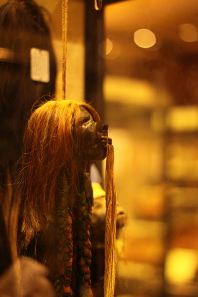By Ursula Kampmann
Translated by Honeycutshome
28 August, 2014 – What people love the most about foreign lands is that they are foreign and hostile. The more foreign and hostile the land to which one had travelled the more amazed the ones staying at home will be. Is it any wonder that shrunken heads became a South American export hit? The prices that seamen and travelers paid for it were high – so high that the shrunken heads were then produced not only of ‘genuine’ trophies from headhunting but innocent dead that were already lying in their graves. Since the 1920s, goats were used, too, that provided skin and hair for replicas that looked deceptively similar to the real thing.
This is certainly no glorious chapter in the souvenir industry. Plus, the taste of the travelers is questionable. But it is part of our history. People simply love the extraordinary, and the market supplies the extraordinary. The testimonies to this human quality are dispersed amongst museums and collections all around the world. The Ethnological Museum Munich, which has an excellent collection on South America, quite likely owns more than one shrunken head, too.
This is by no means something unusual. Human remains have found their way into museums in diverse forms. They come as bones and cremation remains in museums for Pre- and Early History. They come as mummies in Egyptological museums and are – carefully preserved in alcohol – objects of medical-historical collections. Naturally, the state does not feel offended by the parts of dead bodies displayed there. Being part of a private collection, however, they are against the state’s consciousness. Only recently, this happened in Munich.
Shrunken head from the Pitt Rivers Museum, Oxford. Photo: Narayan k28 / Wikipedia.
A well-known auction house, specialized in weapons, offered a shrunken head for sale with the following description: ‘Well-preserved, impressive shrunken head. A striking testimony to the custom of headhunting, which was still practiced in the 1950s, amongst the South American Indian peoples.’ 2,500 euros was the pre-sale estimate of the item, and that incurred the displeasure of an administrative director of the Munich City Cemeteries. Three days prior to the auction, she tried to stop the sale, by calling several times and writing an email. And she succeeded. The auctioneer withdrew the object.
What happened in the aftermath, though, was not in the interests of the City Cemeteries. The auctioneer felt a greater obligation to the consigner than to an administrative director of the Munich City Cemeteries who, by the way, presented neither a file of the State Ministry nor a legal basis of her request. He returned the object to its owner, much to the disgust of the office that had threatened in his letter: ‘We furthermore inform you that, in accordance with art. 18. nr. 11 BestG, it will be considered an administrative offence if you prevent or attempt to prevent the mandatory disposal of the shrunken head at a cemetery.’ Since precisely that had happened, the office intends to inflict a penalty payment amounting to 2,500 euros upon the auction house, in case the auctioneer did not retrieve the shrunken head immediately, in order to ‘temporarily hand it over to the experts of the State Ministry of Cultural Affairs in whose custody it will be xamined in more detail’.
The Windeby Girl. Museum Schloss Gottorf, Schleswig. Photo: Commander-pirx / Wikipedia.
Apart from the fact that it is always amazing to see what highly-qualified experts the State Ministry of Cultural Affairs employs, the standards applied by the Bavarian authorities are rather questionable. If the City Cemeteries want to get their hands on a dead body why not retrieve the ‘Peiting Woman’, displayed at Rottau? That would be a complete, well-preserved corpse, so that the office did not have to quote that it is ‘a shrunken part of a human’s dead body which, in accordance with art. 6 sect. 3 ‘Bestattungsgesetz’ (BestG) read in conjunction with art. 5 BestG and art. 149 ‘Bayerische Verfassung’ (BV) has to disposed of at a cemetery immediately and in a way that is decent and harmless to health.’
This creates the impression that the officials consider scientifically examined corpses, which in addition flush money into the museum’s coffers, good and parts of corpses in the hands of collectors bad.
Is Ötzi truly happy with thousands of tourists staring at his dead body every day? He probably is not hurting any more than the involuntary supplier of the shrunken head in dispute which almost certainly will become the subject of a costly and complex legal quarrel.
And the only reason for this is that some officials pay no attention to the plank in their own eye but feel incredibly offended by the speck of sawdust that is in some other’s eye.
Perhaps the City Cemeteries rather intend to increase their target group – after all, burying all the human remains of all the collections in the world would call for a vast number of additional cemeteries.






